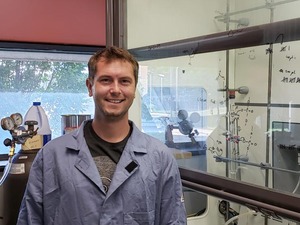A New Protocol for Origins-of-life Research
A new protocol that reduces cost and improves efficiency for origins-of-life research
The RNA World Hypothesis for Prebiotic Life
In living cells today, DNA is the molecule that stores our genetic code. For that DNA to be copied, or replicated, it uses proteins called enzymes and energy-rich molecules like nucleoside triphosphates (NTPs). This DNA replication process is referred to as enzymatic replication. Before modern cells evolved to have enzymes, or to store genetic code in DNA, scientists believe that a molecule, RNA, stored the genetic code and replicated itself without the help of enzymes. For RNA to self-replicate, it would have relied on chemical reactions in its environment, a process known as non-enzymatic or chemical replication.
A major challenge when studying how life began is figuring out the chemical conditions that allowed RNA to replicate itself. To better understand how RNA could have self-replicated, researchers conduct "primer extension" experiments. In these experiments, a short RNA strand (the primer) is lengthened by adding new building blocks called activated mononucleotides, like beads being added to a string. Primer extension experiments mimic how RNA might have copied itself, but they require large amounts of these activated RNA building blocks, which decompose easily and are hard to obtain.
Efficient and Cost-Effective Protocol for Primer Extension Studies

University of Guelph Chemistry Professor Dr. Derek O'Flaherty and his research group developed an efficient, low-cost method to produce these key building blocks, known as 2-aminoimidazole activated mononucleotides. Previous research found that the NTP molecules used in enzymatic replication are not chemically reactive enough to have supported RNA self-replication. However, scientists discovered that if one part of the NTP molecule, called the pyrophosphate group, was swapped with an imidazole group, it made it more reactive and better resembled the conditions that would have been available for RNA to self-replicate.
O'Flaherty’s protocol provides an accessible way for other researchers in the origins-of-life field to produce these activated RNA building blocks in their own labs. This new protocol addresses a crucial gap because prior to O'Flaherty’s article, there wasn’t a clear method available for making these molecules, which are essential for studying how RNA might have replicated without enzymes.
"Our protocol allows origins-of-life researchers to efficiently synthesize these crucial molecules with high yields and purity in their own labs," said Dr. O'Flaherty. By making these molecules more accessible, it opens up new opportunities to explore how RNA might have replicated itself in early life forms, which helps researchers better understand the chemical origins of life on Earth. Going forward, O'Flaherty and his team plan to explore the limits of these 2-aminoimidazole activated mononucleotides in primer extension experiments.
This work was supported by a Natural Sciences and Engineering Research Council of Canada Discovery Grant, a Natural Sciences and Engineering Research Council of Canada Alliance Catalyst Grant, and the Human Frontier Science Program Research Grant — Early Career.
Robinson J.D., Sammons S. R., O’Flaherty, D.K. Preparation of 2-aminoimidazole-activated substrates for the study of nonenzymatic genome replication. Current Protocols. 2024. doi: 10.1002/cpz1.1119